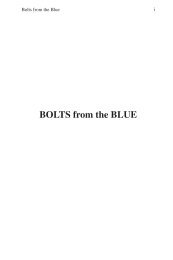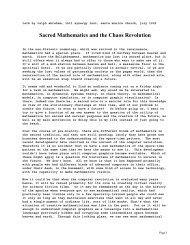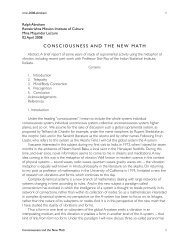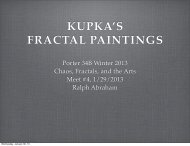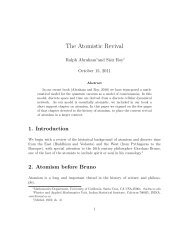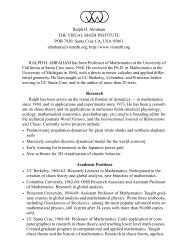Chapter 10. The chaos and fractals of Paris - Ralph Abraham
Chapter 10. The chaos and fractals of Paris - Ralph Abraham
Chapter 10. The chaos and fractals of Paris - Ralph Abraham
Create successful ePaper yourself
Turn your PDF publications into a flip-book with our unique Google optimized e-Paper software.
322 Bolts from the Blue<br />
Poincaré<br />
Jules Henri Poincaré (1854 - 1912) earned the Ph.D. in mathematics<br />
from the Ecole Polytechnique in <strong>Paris</strong> in 1879. His talent was<br />
quickly manifest, <strong>and</strong> he became Pr<strong>of</strong>essor at the University <strong>of</strong> <strong>Paris</strong> in<br />
1881. He is now considered one <strong>of</strong> the great mathematicians <strong>of</strong> all time<br />
for his contributions in several traditional branches <strong>of</strong> mathematics, as<br />
well as his pioneering work in the creation <strong>of</strong> algebraic topology. Also<br />
to his credit is the discovery <strong>of</strong> chaotic dynamics in 1889, which cast<br />
<strong>of</strong>f the anchor <strong>of</strong> the deterministic paradigm <strong>of</strong> the sciences, initiating a<br />
paradigm shift which culminated only recently in <strong>chaos</strong> theory, a new<br />
branch <strong>of</strong> mathematics.<br />
Poincaré wrote over 500 papers, <strong>and</strong> several books, mostly highlevel<br />
works <strong>of</strong> technical mathematics. However, he also published<br />
many papers in popular journals, <strong>and</strong> four nontechnical books, before<br />
his premature death at the age <strong>of</strong> 58.<br />
<strong>The</strong> revolutionary artists <strong>of</strong> the modern art movement were greatly<br />
stimulated by the paradigm shifts <strong>of</strong> the sciences. Popular accounts by<br />
Bertr<strong>and</strong> Russell <strong>and</strong> Arthur Eddington were widely influential in<br />
Engl<strong>and</strong>. (Waddington, 1969, p. 100)<br />
Shortly afterward, the four popular books <strong>of</strong> Poincaré were widely<br />
read by artists <strong>and</strong> intellectuals in France, <strong>and</strong> had an effect on the<br />
development <strong>of</strong> the modern art movement in <strong>Paris</strong>. (Henderson, 1983,<br />
pp. 36, 97) (Shlain, 1991, pp. 195, 431) <strong>The</strong>se books are:<br />
• Science <strong>and</strong> Hypothesis (first Fr. ed., 1902),<br />
• <strong>The</strong> Value <strong>of</strong> Science (1904),<br />
• Science <strong>and</strong> Method (1908), <strong>and</strong><br />
• Last Thoughts (1913).<br />
English translations <strong>of</strong> the first three <strong>of</strong> these were republished in one<br />
volume, <strong>The</strong> Foundations <strong>of</strong> Science, in 1913. Among the influential<br />
ideas are: non-euclidean geometry, the fourth dimension, x-rays, spatial<br />
perception, chance <strong>and</strong> probability, etc.<br />
From our perspective today, we are particularly interested in<br />
Poincaré’s discovery in December <strong>of</strong> 1889 <strong>of</strong> the homoclinic tangle, the<br />
first example <strong>of</strong> a chaotic dynamical system. (Barrow-Greene, 1997,




